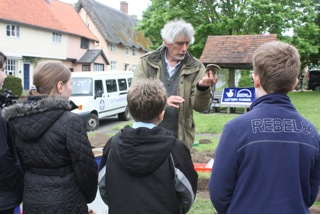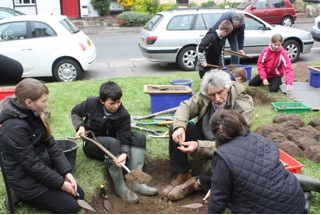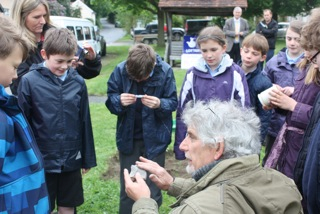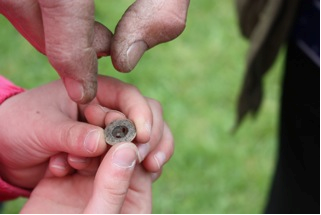Test Pits 39 & 40. Low Street Village Green
Property description and location

Low Street village green is a triangular area of c.0.1ha measuring c.80m in length and c.20m in width at its northern edge before tapering to a point to the south. It is bordered to the east by Low Street, and a pedestrian pathway which continues the line of Church Hill, to the east. To the north lies a block of housing infilling a larger triangle between Low Street, Church Hill and Green Street. The Green itself is broadly flat, the main slope up to Green Street starting at its northern boundary.
The layout of the Green is long-established, the majority of the surrounding houses are listed, ranging from 15th to 18th century in date, and the open area of the Green is clearly shown on the stylised 1619 map of Hoxne Hall and the Tithe map. Apart from the separation of the modern green into several areas of lawn by modern driveways or paths it is also largely unchanged from its depiction on the 1st to 3rd Editions of the Ordnance Survey, apart from the removal of a well or pumphouse in the north-west corner and the relocation of its shelter to the centre.
Test Pit description

The two Test Pits were placed near the centre of the Green, broadly in front of Market House. Each pit measured 1.5m square and was excavated to a depth of 0.3m in a 10cm spit, then a 20cm spit. Both pits showed a soil profile of loam rich stony top soil underlying the turf. At a depth of 30cm the soil became more compacted and gravely, and contained occasional fragments of brick and tile.
Test Pit finds summary

The two pits contained small amounts of post-medieval pottery, including Glazed red earthenware, Frechen stoneware, Nottinghamshire type stoneware and Tin-glazed earthenware, together with a range of other post-medieval or modern artefacts such as ceramic building material, clay tobacco pipe fragments, animal bone with butchery marks and oyster shell, iron nails and other metalwork such as 20th century coinage. The clay pipe included three bowls of which one, from Test Pit 39, Spit 1, was particularly early, dating to the late 16th/early 17th century.

For the schoolchildren digging the pits the discovery of a marble and two heel irons from children's boots gave them a tangible link to children of the past while the clay tobacco pipe bowls and stems illustrated changes in smoking practice as well as changes in social attitudes to this practice. The discovery of a slate pencil was a lovely illustration of school life in the late 19th century and the discovery of two buttons; one a late 19th/early 20th century shirt button and another of plastic from the later 20th century showed that some things donít change Ė buttons do fall off and get lost! Similarly the schoolchildren were encouraged to think about where else the material could have come from, for instance did the various bone fragments, some of which showed signs of butchery, come from a butchers shop that used to be sited on the green?
Test Pit Discussion
The test pits simply cut through a heavily worked topsoil deposit dating to the 20th century and likely to have been affected by modern landscaping. The apparent change in soil at 0.3m depth probably indicates that a former soil horizon, perhaps post-medieval date is present. A range of residual post-medieval finds however were collected amidst the greater quantities of modern material, the small amounts of pottery reflecting the long established use of the site as an open green rather than private occupation. The material, being varied and interesting in nature, provided the pupils with evidence for activity on the site from the 16th through to the late 20th century, the late 16th/early 17th century clay tobacco pipe bowl being of particular note.
Table of Finds - Test Pit 39
| Spit No | Context No | Sieved? | Display/ Keep? | Pottery | Post Med/ modern | Medieval | CBM | Fired Clay | Mortar/ Plaster | Clay Pipe | Glass | Flint | Slate | Plastic | Iron Nails | Iron Other | Other Metalwork | Animal Bone | Oyster Shell | Land Snail | Comments |
|---|---|---|---|---|---|---|---|---|---|---|---|---|---|---|---|---|---|---|---|---|---|
| 1 | 1 | 100% | Yes | Yes | Yes | Yes | Yes | Yes | 1 very early tobacco pipe bowl fragment, L16th-17th C? | ||||||||||||
| 2 | 1 | 100% | Yes | Yes | Yes | Yes | Yes | Yes | Yes | Yes | Yes | Yes | Fragment of animal bone shows butchery marks |
Table of Finds - Test Pit 40
| Spit No | Context No | Sieved? | Display/ Keep? | Pottery | Post Med/ modern | Medieval | CBM | Fired Clay | Mortar/ Plaster | Clay Pipe | Glass | Flint | Slate | Plastic | Iron Nails | Iron Other | Other Metalwork | Animal Bone | Oyster Shell | Land Snail | Comments |
|---|---|---|---|---|---|---|---|---|---|---|---|---|---|---|---|---|---|---|---|---|---|
| 1 | 1 | 100% | Yes | Yes | Yes | Yes | Yes | Yes | Yes | Yes | Yes | Yes | Yes | 2 clay pipe bowl fragments, one with spur with maker's mark (E 18th C?), glass marble, slate pencils | |||||||
| 2 | 1 | 100% | Yes | Yes | Yes | Yes | Yes | Yes | Yes | Yes | Yes | Yes | Glass stopper and two heel irons |
Details of Pottery Finds - Test Pit 39
| Spit No | Context No | Display/ Keep? | Post Med/ modern | Medieval | Details |
|---|---|---|---|---|---|
| 1 | 1 | Yes | Victorian + 1 sherd GRE 1(16th-18th C) | ||
| 2 | 1 | Yes | Victorian + 1 NOTS + 1 Very abraded GRE 16th-18th C |
Details of Pottery Finds - Test Pit 40
| Spit No | Context No | Display/ Keep? | Post Med/ modern | Medieval | Details |
|---|---|---|---|---|---|
| 1 | 1 | Yes | Victorian + 1 NOTS (18th C) + 1 TGE pharmaceutical jar base (16th-18th C) | ||
| 2 | 1 | Yes | Victorian + 1 sherd Frechen stoneware (1550-1700) |